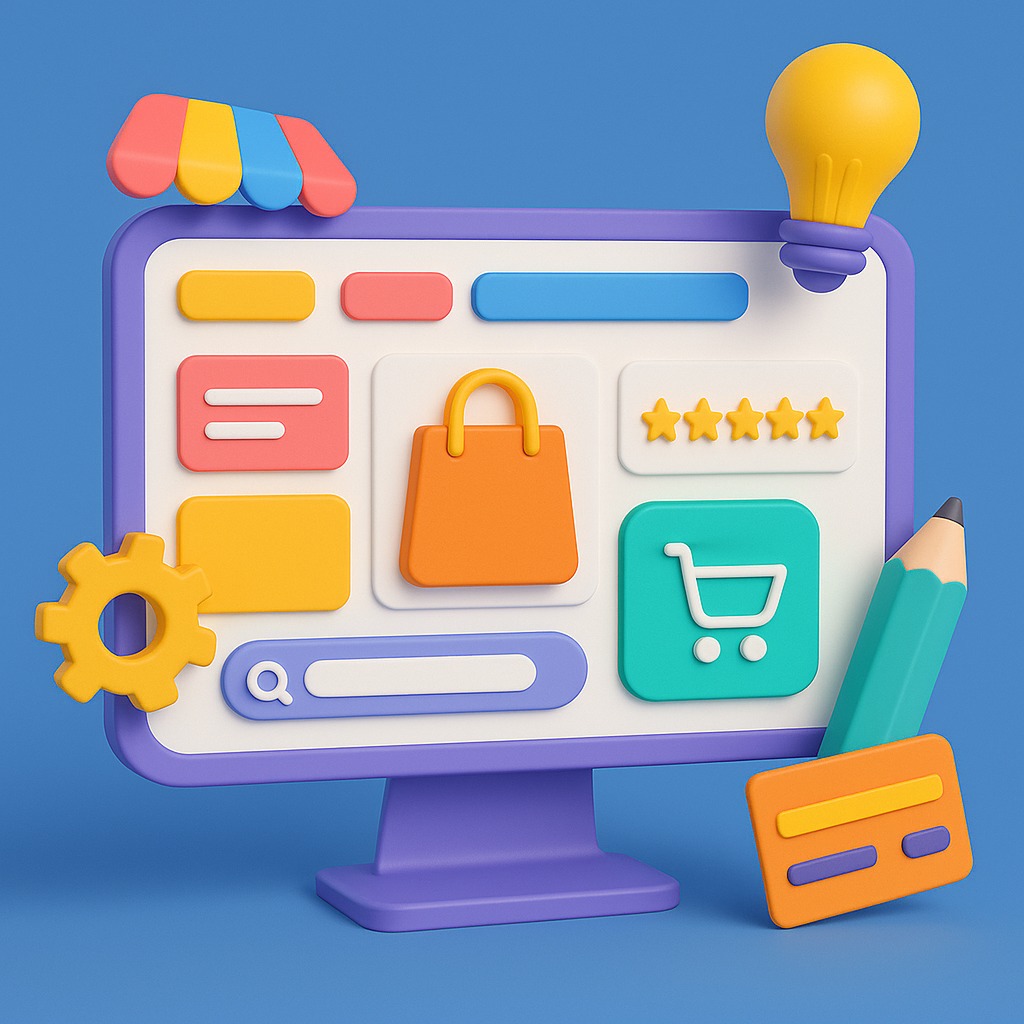How to Design an E-commerce Website: 7 Easy Steps to Build Trust, Boost Sales & Wow Visitors #ecommerce #ux #design
How to Design an E-commerce Website: 7 Easy Steps to Build Trust, Boost Sales & Wow Visitors
Introduction: Why Design Is the Heartbeat of E-commerce
How to design an e-commerce website that actually converts? It starts with ditching the cookie-cutter templates and embracing a customer-first mindset. In the age of Shopify stores and next-day delivery, attention spans are shorter, expectations higher, and trust harder to earn. That’s why your website design isn’t just about aesthetics—it’s your silent salesperson, open 24/7, whispering to every visitor: “You’re in the right place.”
In this guide, we’ll walk you through 15+ design strategies to build a digital storefront that’s not only beautiful, but strategically structured to drive loyalty and sales. Let’s dive in.
1. Understand Your Audience
Before you sketch a wireframe or pick a theme, ask: Who is this for? Are they busy moms, tech-savvy millennials, or B2B buyers? Building accurate buyer personas helps you align tone, structure, and layout with real human needs.
Buyer Personas 101: Use tools like HubSpot’s persona generator or Google Analytics demographics.
Designing with Intent: A high-end fashion site should feel different from a rugged outdoor gear shop.
Affiliate Tip: Recommend persona tools and surveys via affiliate links for added monetization.
2. Choose the Right Layout
Layout sets the visual and navigational rhythm. Think of it like arranging furniture in a physical store—you want people to linger, not bounce.
Homepage Flow: Feature your value prop, trust markers, and product categories up top.
Product Page Structure: Prioritize clean visuals, reviews, price, and CTAs above the fold.
How to design an e-commerce website with good layout? Start by A/B testing key elements.
3. Optimize Navigation
Confused visitors don’t buy—they leave. Your nav bar must be clear, uncluttered, and frictionless.
Mega Menus vs. Simple Menus: Large catalogs benefit from mega menus. Smaller ones? Stick to essentials.
Breadcrumbs & Sticky Nav: These help users backtrack or explore deeper without starting over.
CPA Opportunity: Link to UX audit services that evaluate site navigation.
4. Use Trust-Building Design Elements
Trust can’t be bought—it must be designed. Customers judge credibility within seconds.
Reviews, Badges & Seals: Display security badges, customer reviews, and payment trust logos.
Live Chat, FAQs & Transparency: Give users quick ways to answer doubts.
How to design an e-commerce website that screams credibility? Show you’re real, safe, and responsive.
5. Prioritize Mobile-First Design
Over 60% of e-commerce traffic comes from mobile. Designing desktop-first is like building a store for ghosts.
Mobile UX Best Practices: Tap targets, speed, thumb-friendly layouts.
Responsive vs Adaptive: Responsive is more scalable, adaptive is more controlled.
Affiliate Opportunity: Promote responsive design themes or mobile optimization plugins.
6. Craft Conversion-Focused CTAs
A great site doesn’t beg for clicks—it guides them.
CTA Placement & Copywriting: Use active verbs. Instead of “Submit,” say “Get My Discount.”
Button Colors That Convert: Test high-contrast colors like orange or green against your palette.
How to design an e-commerce website CTA strategy? Combine urgency + clarity + placement.
7. Master Visual Hierarchy
Your layout should visually guide the customer’s eye to what matters.
Fonts, Colors, and Whitespace: Use bold headers, soft contrasts, and breathing space.
Focal Points That Guide: Highlight offers, categories, or timers with directional cues.
Affiliate Tip: Link to premium font kits or color palette generators.
8. Leverage High-Quality Product Imagery
Customers can’t touch your product. So your images need to almost let them.
Lifestyle vs Plain Shots: Lifestyle builds emotion. Plain builds clarity. Use both.
Image Zoom & Gallery UX: Zoom, hover, 360°—the more visual confidence, the better.
How to design an e-commerce website that converts browsers into buyers? Invest in product photography.
9. Improve Site Speed and Performance
Fast sites earn more money. Period.
Lazy Loading: Load images as users scroll.
Image Optimization Tools: Use TinyPNG, ShortPixel, or CDN compression.
CPA Tip: Speed audit tools and CDNs often offer affiliate or referral options.
10. Keep Forms Short and Sweet
Long forms kill conversions faster than pop-ups at midnight.
Checkout UX: Collapse steps into progress bars. Use autofill.
Form Field Reduction: Ask only what you need—email, name, maybe shipping.
How to design an e-commerce website checkout? Streamline like a one-lane highway.
11. Integrate Social Proof Everywhere
When users hesitate, peer reassurance converts them.
Testimonials: Add rotating quotes or videos.
UGC & Influencer Highlights: Showcase real people using your products.
Affiliate Bonus: Link to platforms like Loox or Trustpilot for social proof integration.
12. Apply SEO Best Practices in Design
A beautiful store no one sees is still invisible.
Heading Hierarchy: Use H1–H4 properly for indexing.
Internal Linking: Link products to categories and blog content.
How to design an e-commerce website that ranks? Bake in SEO as early as layout planning.
13. Include Clear Return & Shipping Info
Uncertainty is the enemy of checkout.
Policy Placement: Add links in footers, carts, and FAQs.
Reducing Purchase Anxiety: Offer money-back guarantees or easy returns.
Affiliate Hook: Highlight shipping tools or platforms like AfterShip.
14. Use Analytics to Track Behavior
What gets measured, gets improved.
Heatmaps & Scrollmaps: See where users click, stall, or leave.
A/B Testing: Test headlines, CTAs, layouts every quarter.
How to design an e-commerce website that evolves? Trust the data, not just instinct.
15. Keep Testing and Iterating
No design is final. Think MVP, not perfection.
Feedback Loops: Collect user feedback regularly.
Design Sprints: Tackle updates in 1–2 week bursts.
CPA Suggestion: Offer UX review tools or design sprint workshops.
Bonus: Common Design Mistakes to Avoid
Overcluttered Pages: Keep it clean—don’t bombard users.
Too Many Fonts or Colors: Stick to 2–3 max.
Neglecting Mobile: Prioritize it from day one.
How to design an e-commerce website that succeeds? Avoid trying to please everyone—serve your niche flawlessly.
Final Thoughts: Design Like You Mean It
In the end, how to design an e-commerce website isn’t just a technical question—it’s emotional. It’s about removing friction, building trust, and creating delight in every scroll, click, and checkout. Whether you’re using Shopify, WooCommerce, or custom code, great design bridges the gap between intent and action.
You’ve got the blueprint—now bring it to life.
✅ Bullet-Point Summary (5–15 points)
Understand your audience through detailed buyer personas before designing.
Choose a layout that aligns with your brand and shopping behavior expectations.
Use clear, intuitive navigation (e.g., sticky nav, breadcrumbs) to reduce friction.
Build trust through design with reviews, security badges, and live chat options.
Prioritize mobile-first design, ensuring fast load times and thumb-friendly layouts.
Use clear, action-oriented calls-to-action (CTAs) in strategic locations.
Leverage visual hierarchy with consistent fonts, color usage, and whitespace.
Showcase high-quality, zoomable product imagery to simulate tactile experience.
Optimize site speed with image compression, lazy loading, and CDNs.
Simplify checkout and form fields to reduce drop-offs and friction.
Add social proof—testimonials, UGC, influencer mentions—to reinforce buyer confidence.
Apply SEO-friendly structure (heading tags, internal linking, fast performance).
Make return/shipping info easy to find to reduce cart abandonment.
Monitor behavior with heatmaps, analytics, and A/B testing.
Continually improve through feedback loops and design sprints.
Frequently Asked Questions (FAQs)
1. How do I start designing an e-commerce website from scratch?
Start with defining your niche and target audience. Then choose a platform (e.g., Shopify, WooCommerce), select a theme, and prioritize layout, UX, and mobile-friendliness.
2. What layout works best for online stores?
Clean, product-focused layouts with clear CTAs, easy navigation, and trust elements work best. Keep important info above the fold.
3. How can I make my e-commerce website mobile-friendly?
Use responsive design, optimize tap targets, minimize image load, and test on various screen sizes regularly.
4. What trust elements should be on my e-commerce site?
Customer reviews, SSL badges, money-back guarantees, live chat, and clear contact information all build trust.
5. How do CTAs impact conversion rates?
Effective CTAs guide users toward desired actions. Placement, color, and wording (e.g., “Buy Now” vs “Submit”) matter greatly.
6. Should I use a template or custom design?
Templates are faster and budget-friendly. Custom design gives more control and uniqueness, ideal for scaling brands.
7. How do I improve product pages?
Use high-quality images, compelling descriptions, social proof, and make the CTA prominent.
8. What SEO practices help e-commerce sites rank?
Use proper heading tags, compress images, build internal links, and write keyword-optimized meta content.
9. How often should I update my website design?
At least once a year—or sooner if analytics show drop-offs or user behavior changes significantly.
10. What are common mistakes in e-commerce design?
Overdesigning, slow loading times, unclear navigation, and ignoring mobile users.
11. How can I test if my design is working?
Use tools like Google Analytics, heatmaps, A/B tests, and direct user feedback.
12. Are animations or videos good for product pages?
Yes—if they enhance clarity or storytelling without slowing down the site.
13. What role does color psychology play in design?
Colors evoke emotion and influence decision-making. Use consistent, intentional palettes.
14. How do I structure product categories effectively?
Use logical, SEO-friendly categories and subcategories. Keep it shallow (3 levels max) and user-intuitive.
15. Can I build a successful store without design experience?
Absolutely! Use reliable tools, follow proven design principles, or hire experienced professionals through services.
Broaden Your Knowledge with These Sources
To support your learning and take your e-commerce strategy even further, explore the following expert-curated resources. Each link has been carefully selected to offer in-depth insights, practical guidance, or cutting-edge research:
Baymard Institute – E-commerce UX Research: Learn from extensive usability testing and benchmark data.
Smashing Magazine – E-commerce Design Tips: Stay up to date with modern design practices.
Google PageSpeed Insights: Evaluate your site’s performance and receive actionable speed improvement suggestions.
Hotjar – Behavior Analytics: Discover how visitors interact with your website through heatmaps and recordings.
Neil Patel’s Blog: Explore SEO and conversion tips tailored for online stores.
Shopify Blog – Commerce Trends: Get the latest updates on e-commerce growth strategies.
HubSpot’s Marketing Hub: Learn how to align design with inbound marketing.
Crazy Egg – Website Optimization Tools: Use scroll maps and user testing tools to fine-tune design.
W3C Web Accessibility Guidelines: Ensure your website is inclusive and accessible to all users.
Content Marketing Institute: Discover how to weave effective content into your design for engagement.
By following these resources, you’ll not only reinforce what you’ve learned but also uncover new perspectives that can sharpen your competitive edge. Let your design evolve through expert insights and continuous learning.



